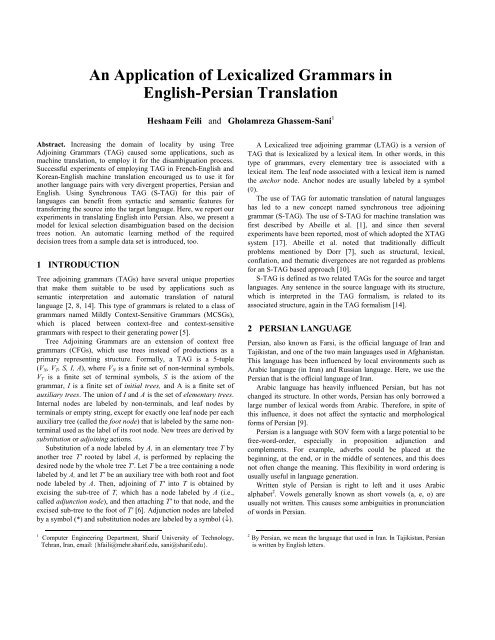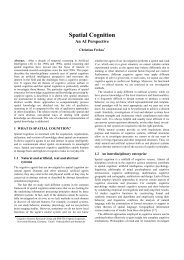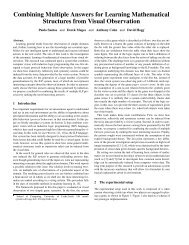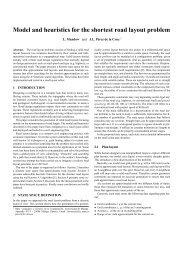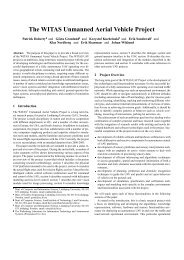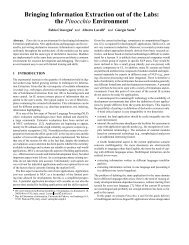An Application of Lexicalized Grammars in English ... - CiteSeerX
An Application of Lexicalized Grammars in English ... - CiteSeerX
An Application of Lexicalized Grammars in English ... - CiteSeerX
You also want an ePaper? Increase the reach of your titles
YUMPU automatically turns print PDFs into web optimized ePapers that Google loves.
<strong>An</strong> <strong>Application</strong> <strong>of</strong> <strong>Lexicalized</strong> <strong>Grammars</strong> <strong>in</strong><strong>English</strong>-Persian TranslationHeshaam Feili and Gholamreza Ghassem-Sani 1Abstract. Increas<strong>in</strong>g the doma<strong>in</strong> <strong>of</strong> locality by us<strong>in</strong>g TreeAdjo<strong>in</strong><strong>in</strong>g <strong>Grammars</strong> (TAG) caused some applications, such asmach<strong>in</strong>e translation, to employ it for the disambiguation process.Successful experiments <strong>of</strong> employ<strong>in</strong>g TAG <strong>in</strong> French-<strong>English</strong> andKorean-<strong>English</strong> mach<strong>in</strong>e translation encouraged us to use it foranother language pairs with very divergent properties, Persian and<strong>English</strong>. Us<strong>in</strong>g Synchronous TAG (S-TAG) for this pair <strong>of</strong>languages can benefit from syntactic and semantic features fortransferr<strong>in</strong>g the source <strong>in</strong>to the target language. Here, we report ourexperiments <strong>in</strong> translat<strong>in</strong>g <strong>English</strong> <strong>in</strong>to Persian. Also, we present amodel for lexical selection disambiguation based on the decisiontrees notion. <strong>An</strong> automatic learn<strong>in</strong>g method <strong>of</strong> the requireddecision trees from a sample data set is <strong>in</strong>troduced, too.1 INTRODUCTIONTree adjo<strong>in</strong><strong>in</strong>g grammars (TAGs) have several unique propertiesthat make them suitable to be used by applications such assemantic <strong>in</strong>terpretation and automatic translation <strong>of</strong> naturallanguage [2, 8, 14]. This type <strong>of</strong> grammars is related to a class <strong>of</strong>grammars named Mildly Context-Sensitive <strong>Grammars</strong> (MCSGs),which is placed between context-free and context-sensitivegrammars with respect to their generat<strong>in</strong>g power [5].Tree Adjo<strong>in</strong><strong>in</strong>g <strong>Grammars</strong> are an extension <strong>of</strong> context freegrammars (CFGs), which use trees <strong>in</strong>stead <strong>of</strong> productions as aprimary represent<strong>in</strong>g structure. Formally, a TAG is a 5-tuple(V N , V T , S, I, A), where V N is a f<strong>in</strong>ite set <strong>of</strong> non-term<strong>in</strong>al symbols,V T is a f<strong>in</strong>ite set <strong>of</strong> term<strong>in</strong>al symbols, S is the axiom <strong>of</strong> thegrammar, I is a f<strong>in</strong>ite set <strong>of</strong> <strong>in</strong>itial trees, and A is a f<strong>in</strong>ite set <strong>of</strong>auxiliary trees. The union <strong>of</strong> I and A is the set <strong>of</strong> elementary trees.Internal nodes are labeled by non-term<strong>in</strong>als, and leaf nodes byterm<strong>in</strong>als or empty str<strong>in</strong>g, except for exactly one leaf node per eachauxiliary tree (called the foot node) that is labeled by the same nonterm<strong>in</strong>alused as the label <strong>of</strong> its root node. New trees are derived bysubstitution or adjo<strong>in</strong><strong>in</strong>g actions.Substitution <strong>of</strong> a node labeled by A, <strong>in</strong> an elementary tree T byanother tree T' rooted by label A, is performed by replac<strong>in</strong>g thedesired node by the whole tree T'. Let T be a tree conta<strong>in</strong><strong>in</strong>g a nodelabeled by A, and let T' be an auxiliary tree with both root and footnode labeled by A. Then, adjo<strong>in</strong><strong>in</strong>g <strong>of</strong> T' <strong>in</strong>to T is obta<strong>in</strong>ed byexcis<strong>in</strong>g the sub-tree <strong>of</strong> T, which has a node labeled by A (i.e.,called adjunction node), and then attach<strong>in</strong>g T' to that node, and theexcised sub-tree to the foot <strong>of</strong> T' [6]. Adjunction nodes are labeledby a symbol (*) and substitution nodes are labeled by a symbol (↓).1 Computer Eng<strong>in</strong>eer<strong>in</strong>g Department, Sharif University <strong>of</strong> Technology,Tehran, Iran, email: {hfaili@mehr.sharif.edu, sani@sharif.edu}.A <strong>Lexicalized</strong> tree adjo<strong>in</strong><strong>in</strong>g grammar (LTAG) is a version <strong>of</strong>TAG that is lexicalized by a lexical item. In other words, <strong>in</strong> thistype <strong>of</strong> grammars, every elementary tree is associated with alexical item. The leaf node associated with a lexical item is namedthe anchor node. <strong>An</strong>chor nodes are usually labeled by a symbol(◊).The use <strong>of</strong> TAG for automatic translation <strong>of</strong> natural languageshas led to a new concept named synchronous tree adjo<strong>in</strong><strong>in</strong>ggrammar (S-TAG). The use <strong>of</strong> S-TAG for mach<strong>in</strong>e translation wasfirst described by Abeille et al. [1], and s<strong>in</strong>ce then severalexperiments have been reported, most <strong>of</strong> which adopted the XTAGsystem [17]. Abeille et al. noted that traditionally difficultproblems mentioned by Dorr [7], such as structural, lexical,conflation, and thematic divergences are not regarded as problemsfor an S-TAG based approach [10].S-TAG is def<strong>in</strong>ed as two related TAGs for the source and targetlanguages. <strong>An</strong>y sentence <strong>in</strong> the source language with its structure,which is <strong>in</strong>terpreted <strong>in</strong> the TAG formalism, is related to itsassociated structure, aga<strong>in</strong> <strong>in</strong> the TAG formalism [14].2 PERSIAN LANGUAGEPersian, also known as Farsi, is the <strong>of</strong>ficial language <strong>of</strong> Iran andTajikistan, and one <strong>of</strong> the two ma<strong>in</strong> languages used <strong>in</strong> Afghanistan.This language has been <strong>in</strong>fluenced by local environments such asArabic language (<strong>in</strong> Iran) and Russian language. Here, we use thePersian that is the <strong>of</strong>ficial language <strong>of</strong> Iran.Arabic language has heavily <strong>in</strong>fluenced Persian, but has notchanged its structure. In other words, Persian has only borrowed alarge number <strong>of</strong> lexical words from Arabic. Therefore, <strong>in</strong> spite <strong>of</strong>this <strong>in</strong>fluence, it does not affect the syntactic and morphologicalforms <strong>of</strong> Persian [9].Persian is a language with SOV form with a large potential to befree-word-order, especially <strong>in</strong> proposition adjunction andcomplements. For example, adverbs could be placed at thebeg<strong>in</strong>n<strong>in</strong>g, at the end, or <strong>in</strong> the middle <strong>of</strong> sentences, and this doesnot <strong>of</strong>ten change the mean<strong>in</strong>g. This flexibility <strong>in</strong> word order<strong>in</strong>g isusually useful <strong>in</strong> language generation.Written style <strong>of</strong> Persian is right to left and it uses Arabicalphabet 2 . Vowels generally known as short vowels (a, e, o) areusually not written. This causes some ambiguities <strong>in</strong> pronunciation<strong>of</strong> words <strong>in</strong> Persian.2 By Persian, we mean the language that used <strong>in</strong> Iran. In Tajikistan, Persianis written by <strong>English</strong> letters.
3 TRANSLATING ENGLISH INTO PERSIAN<strong>English</strong> and Persian have a wide range <strong>of</strong> differences, <strong>in</strong> bothstructural and lexical aspects. Unlike strict SVO word order <strong>of</strong><strong>English</strong>, Persian uses a SOV pattern with relatively free wordorder.Morphological analysis <strong>of</strong> Persian differs from <strong>English</strong> <strong>in</strong>various ways. Persian morphology is an affixal system consist<strong>in</strong>g<strong>of</strong> ma<strong>in</strong>ly suffixes and a few prefixes. There are a relatively smallnumber <strong>of</strong> affixes <strong>in</strong> the language that obey a regular morphotacticorder. These affixes are jo<strong>in</strong>ed to the root form <strong>of</strong> words <strong>in</strong> order toproduce the correct form.S-TAG seems to be an appropriate tool to overcome thesediscrepancies. We’ve developed an S-TAG grammar for <strong>English</strong>-Persian language pair based on the XTAG project [17]. A corpusset conta<strong>in</strong><strong>in</strong>g 860 sentences shorter than 16 words collected fromcomputer related articles and a set <strong>of</strong> 2136 <strong>English</strong> words wereused.We adopted an idea similar to that <strong>of</strong> an <strong>English</strong>-Koreantranslator [8], <strong>in</strong> which the association between peer grammars wasdivided <strong>in</strong>to three different phases, namely: tree transfer, lexicaltransfer, and feature transfer. Figure 1, shows the process <strong>of</strong>translation us<strong>in</strong>g this approach. In the follow<strong>in</strong>g sections we give adetailed account <strong>of</strong> each module.3.1 Pars<strong>in</strong>g PhaseThe first phase <strong>of</strong> the translation process is Pars<strong>in</strong>g. In this phase,each <strong>in</strong>put sentence is analyzed and its structural <strong>in</strong>formation isextracted. Us<strong>in</strong>g a TAG to model the source language, and byhav<strong>in</strong>g a pars<strong>in</strong>g algorithm based on the TAG formalism, such asone described by Van Noord [16], a derivation tree is generated asa result <strong>of</strong> pars<strong>in</strong>g each <strong>in</strong>put sentence (here <strong>in</strong> <strong>English</strong>). Derivationtree is a tree that records the history <strong>of</strong> composition <strong>of</strong> theelementary trees associated with the lexical items <strong>in</strong> the sentences[17]. Derived tree is the syntactic structure <strong>of</strong> the sentence, whichcan be built by us<strong>in</strong>g derivation tree.3.2 Transfer PhaseThis phase, which comprises three different stages, is used totransfer an <strong>English</strong> derivation tree <strong>in</strong>to the correspond<strong>in</strong>g Persianderivation tree.3.2.1 Tree Transfer ModelThe basic idea <strong>of</strong> the transfer module relies on the derivation treesthat are transferred from one language to another. By us<strong>in</strong>g the treetransfer rout<strong>in</strong>e, which conta<strong>in</strong>s all the node-to-nodecorrespondence between elementary trees <strong>of</strong> the S-TAG, targetderivation trees are built. This transfer is only a structural transfer,by which the correct related structure <strong>of</strong> Persian is generated.In Persian, tree transfer sometimes faces some ambiguities. Forexample, the follow<strong>in</strong>g <strong>English</strong> elementary tree, which handles thesentences conta<strong>in</strong><strong>in</strong>g sentential complement with a noun phrase,may be transferred <strong>in</strong>to two different Persian elementary trees,based on the mode <strong>of</strong> the ma<strong>in</strong> verb <strong>of</strong> the embedded sentence.Sentences (1) and (2) below can be parsed by this tree 3 (Thetransliteration used is the same as what was described <strong>in</strong> [3]).3 The elementary tree and examples are borrowed from [15].(1) Sr<strong>in</strong>i begged Mark to <strong>in</strong>crease his disk quotaSr<strong>in</strong>i az Mark barae afzayesh zarfiat disk-ash darkhast-kardSr<strong>in</strong>i Mark to <strong>in</strong>crease quota disk-his begged(2) Beth told Jim that it was his turnBeth be Jim g<strong>of</strong>t keh an noobat-ash boodBeth Jim told that it turn -his wasIn the first sentence, the ma<strong>in</strong> verb <strong>of</strong> the embedded sentence"<strong>in</strong>crease his disk quota" is <strong>in</strong> its <strong>in</strong>f<strong>in</strong>itive form, whereas thesecond example is <strong>in</strong> declarative form. Figure 2(a) shows theelementary tree for declarative sentential complement with NP,while figures 2(b, c), show the associated Persian elementary trees.In the first case, where the embedded sentence has the ma<strong>in</strong> verbwith an <strong>in</strong>f<strong>in</strong>itive form, the sentence appears before the ma<strong>in</strong> verb,while <strong>in</strong> the other one the embedded sentence conjuncts to the end<strong>of</strong> the ma<strong>in</strong> sentence.This example shows a one-to-many relationship between<strong>English</strong> and Persian elementary trees. Some constra<strong>in</strong>ts areassociated with every relation, and are used dur<strong>in</strong>g transferr<strong>in</strong>g thetree structure <strong>of</strong> the source <strong>in</strong>to the target language. Theseconstra<strong>in</strong>ts deal only with the structural <strong>in</strong>formation, which isavailable dur<strong>in</strong>g the transfer phase.There may exist some relations that map many to one <strong>English</strong>-Persian elementary trees. In this case, a whole derivation tree maybe transferred <strong>in</strong>to an elementary tree from <strong>English</strong> to Persian.However, we haven’t faced these phenomena <strong>in</strong> the sample data setthat has been used.The node correspondence between peer elementary trees (sourceand target languages) may have any sort <strong>of</strong> relationships: one-toone,one-to-many, many-to-one, and many-to-many. The nodecorrespondence is used <strong>in</strong> two cases:• The correspondence between the anchor nodes <strong>of</strong> elementarytrees, used <strong>in</strong> the lexical transfer, where the source word istransferred <strong>in</strong>to the target word.• The correspondence between other nodes <strong>of</strong> elementary trees,used dur<strong>in</strong>g manipulation <strong>of</strong> the actions on trees (substitutionor adjunction). <strong>An</strong>y action that is applied to a node <strong>in</strong> thesource tree will be also applied to the correspond<strong>in</strong>g node <strong>of</strong>the target tree.3.2.2 Lexical Transfer ModelBy transferr<strong>in</strong>g a derivation tree, the derived tree can be easilycomputed, and the syntactic structure <strong>of</strong> the target sentence is built.The next phase is to transfer the leaves <strong>of</strong> the derived tree, wherethe lexical is held 4 . This phase, which is named lexical transfer, isa very important but unfortunately ambiguous phase. Lexicalselection becomes more difficult when it deals with some wordsthat have more translation candidates. For example, word "who"can be translated <strong>in</strong>to several different Persian words such as "chekasi" (<strong>in</strong> <strong>in</strong>terrogative sentences), "keh" (<strong>in</strong> relative clauses), etc.This process may be even more difficult when it comes to dealwith some prepositions such as "on", "to", or some specific verbssuch as "get" and "make".4 Notice that the leaves <strong>of</strong> the derived trees correspond to the anchor nodes<strong>of</strong> derivation trees.
Figure 1. The process <strong>of</strong> translation us<strong>in</strong>g S-TAGIn general, word sense disambiguation is one <strong>of</strong> the ma<strong>in</strong>obstacles <strong>in</strong> the way <strong>of</strong> the lexical transfer phase [15]. Here, we<strong>in</strong>troduce a new method to tackle ambiguities that occur dur<strong>in</strong>g thisphase. To that end, we build a decision tree for every ambiguousword. The decisions are made by us<strong>in</strong>g some attributes that are<strong>in</strong>corporated <strong>in</strong>to the decision tree. These attributes are languagedependent, which are <strong>in</strong>stantiated <strong>in</strong> a feature-based lexicalized treeadjo<strong>in</strong><strong>in</strong>g grammar (FB-LTAG) framework [17]. The attributes aredef<strong>in</strong>ed as features <strong>in</strong> the TAG model and get their values by aunification process performed dur<strong>in</strong>g the pars<strong>in</strong>g process. Thedef<strong>in</strong>ed attributes are features that conta<strong>in</strong> both syntactic andsemantic <strong>in</strong>formation <strong>of</strong> the sentences. The ma<strong>in</strong> attributes usedare:• The Part-<strong>of</strong>-speech <strong>of</strong> the anchor node <strong>of</strong> elementary trees,which is the most important attribute to be used dur<strong>in</strong>gdecision-mak<strong>in</strong>g. This attribute reflects the syntactic<strong>in</strong>formation <strong>of</strong> the sentence. For example, know<strong>in</strong>g the part-<strong>of</strong>speech<strong>of</strong> the word "can" leads us to its specific mean<strong>in</strong>g.• The family tree 5 <strong>of</strong> the used elementary trees, which is also animportant attribute to be used dur<strong>in</strong>g decision-mak<strong>in</strong>g, andreflects some semantic properties <strong>of</strong> the <strong>in</strong>put sentence. Forexample, there is a family tree named "ergative" that refers tothe verbs such as "melt", for which the subject plays the role <strong>of</strong>the object. So, <strong>in</strong> this family, the translated sentence should be<strong>in</strong> the passive form [17].• The specific features <strong>of</strong> anchor nodes.• The specific features <strong>of</strong> non-anchor nodes <strong>of</strong> elementary trees.These features are not associated to the anchor <strong>of</strong> tree; ratherthey are connected to other types <strong>of</strong> nodes, which affect themean<strong>in</strong>g <strong>of</strong> the anchor node.participated. The tree family B 2 is related to the auxiliary trees <strong>of</strong>phrases such as "can hold". Hav<strong>in</strong>g this tree, the exact mean<strong>in</strong>g <strong>of</strong>"can" can be determ<strong>in</strong>ed.The word "who" can be translated <strong>in</strong>to three different Persianmean<strong>in</strong>gs: 1) it is used for mak<strong>in</strong>g <strong>in</strong>terrogative sentences. 2) it isused <strong>in</strong> relative clauses. 3) it plays the role <strong>of</strong> a common nounphrase.NP 0 ↓S r(a)VPV◊NP 1 ↓S 2 *SP V◊NP 0 ↓NPS rNP 1 ↓(b)VP2 *NP 0 ↓SP V◊S rNP(c)VPNP 1 ↓V◊Figure 2. (a) The elementary tree <strong>of</strong> a declarative sententialcomplement with NP. (b) The first related Persian elementary tree(the ma<strong>in</strong> verb <strong>of</strong> the embedded sentence is <strong>in</strong> <strong>in</strong>f<strong>in</strong>itive mode).(c) The second related Persian elementary tree (the ma<strong>in</strong> verb <strong>of</strong> theembedded sentence is <strong>in</strong> declarative mode.V◊2 *Automatic Generation <strong>of</strong> Decision TreesAll attributes mentioned <strong>in</strong> the previous section have beenimplemented us<strong>in</strong>g a data set with 2136 lexical items (<strong>in</strong>clud<strong>in</strong>gproper nouns) <strong>of</strong> 860 sentences shorter than 16 words. Us<strong>in</strong>g TAGformalism and after pars<strong>in</strong>g these sentences, all attributes get theirappropriate values, and the correct permutation <strong>of</strong> Persian words isgenerated. By align<strong>in</strong>g the related words <strong>of</strong> <strong>English</strong> and Persiansentences, the <strong>in</strong>formation required for build<strong>in</strong>g a decision tree byus<strong>in</strong>g an algorithm such as ID3 would be available [13].There is a decision tree for every word that appears <strong>in</strong> thetra<strong>in</strong><strong>in</strong>g set. These trees can be derived by us<strong>in</strong>g ID3, whichchooses one attribute at any step to divide the tra<strong>in</strong><strong>in</strong>g set. By us<strong>in</strong>gthese attributes, the optimal decision trees that maximize thega<strong>in</strong>ed <strong>in</strong>formation, are generated.Figure 3 shows the learned decision trees based on our tra<strong>in</strong><strong>in</strong>gdata set for two words: "can" (3.a) and "who" (3.b). The mean<strong>in</strong>g<strong>of</strong> "can" is firstly determ<strong>in</strong>ed by its part-<strong>of</strong>-speech tag. If it is anoun, the Persian word "Kozeh" is selected as its mean<strong>in</strong>g, whereasif it is a verb, it may still either be an auxiliary or a ma<strong>in</strong> verb. This<strong>in</strong>formation is recognized by the elementary tree <strong>in</strong> which it is5 A family tree is a collection <strong>of</strong> semantically related elementary trees [17].Figure 3. Decision trees for the lexical transfer <strong>of</strong> "can" and "who"3.2.3 Feature Transfer ModelThe third phase <strong>of</strong> transfer is the so-called feature transfer. Because<strong>of</strong> the divergences between Persian and <strong>English</strong> words, we need totransfer some features from <strong>English</strong> <strong>in</strong>to Persian, which are laterused to generate the proper form <strong>of</strong> <strong>in</strong>dividual words. Thesefeatures can be divided <strong>in</strong>to two types: structural andmorphological.Structural features are those that are related to a specialstructural form <strong>of</strong> Persian sentences. For example, the differentmodes <strong>of</strong> a verb <strong>in</strong> Persian are different from that <strong>of</strong> <strong>English</strong>. Thus,we need some methods for deriv<strong>in</strong>g these features from the <strong>English</strong>structure.Morphological features are those that <strong>in</strong>flect word surfaceforms. There are some different morphological forms <strong>in</strong> Persian,which should be derived from <strong>English</strong> sentences by assum<strong>in</strong>g theexistence <strong>of</strong> their structural forms. The Persian morphologicalfeatures are listed <strong>in</strong> [11]. In our experiments, all features could bederived from the <strong>English</strong>-Persian S-TAG. For example, there is a
morpheme named Enclitic Particle <strong>in</strong> Persian that forces to attach aletter "i" to the end <strong>of</strong> a noun that is referred to by a relative clause.We extracted the value <strong>of</strong> this feature from all elementary treesrelated to the relative clauses; these trees are well-def<strong>in</strong>ed <strong>in</strong> the<strong>English</strong>-Persian S-TAG notation.structure and order <strong>of</strong> Persian words. After these phases, all wordsare <strong>in</strong> their root form, which need to be <strong>in</strong>flected by the appropriatemorphological rules. For example, there is a morphological rulecalled "ezafe" that attaches the suffix "-e" to the end <strong>of</strong> the firstword <strong>of</strong> a compound NP.3.3 Morphological Rule ApplierSNPNPVPNPNPThe f<strong>in</strong>al phase <strong>of</strong> translation, which happened to be the simplestone, <strong>in</strong>volves the application <strong>of</strong> Persian morphological rules. Afterperform<strong>in</strong>g feature transformation, some modifications are appliedto <strong>in</strong>dividual words by us<strong>in</strong>g some morphological rules. The ma<strong>in</strong>property <strong>of</strong> this phase is the locality <strong>of</strong> its action: each rule appliesonly to a s<strong>in</strong>gle word, and does not affect the long distant words.We have implemented all those morphological rules that have beenexpla<strong>in</strong>ed <strong>in</strong> [12].NP 0 ↓ VPNP 1 ↓V◊(α 1 )SNP 0 ↓ VPNP 1 ↓ ra(Fα 1 )(α 2 )Ν◊Ν◊NP ∗(β 1 )AUX◊VP ∗(β 2 )VPAUX◊VP ∗(Fβ 2 )4 A COMPLETE EXAMPLEIn this section, we <strong>in</strong>troduce a complete example <strong>of</strong> <strong>English</strong>-Persian translation. The sentence pair is:(3) Our s<strong>of</strong>tware solutions can create customized packages foryour special needsrah-ehal-ha-i narm-afzar-i ma mi-tavan-ad basteh-ha-ivizheh ra barai-e niaz-ha-i khas-e shoma tolid kon-adsolutions s<strong>of</strong>tware our can packagescustomized for needs special your createBy apply<strong>in</strong>g a TAG-based pars<strong>in</strong>g algorithm to the above<strong>English</strong> sentence, the derivation tree shown <strong>in</strong> figure 4 is obta<strong>in</strong>ed.Each node <strong>of</strong> this tree refers to an elementary tree with its lexicalvalues associated to its anchor.The list <strong>of</strong> elementary trees with their associated Persianelementary trees is shown <strong>in</strong> figure 5 6 . For every elementary tree,the prefix letter F refers to its associated Persian one. Note that,there are usages <strong>of</strong> Noun and Adjective adjunctions <strong>in</strong> the auxiliarytrees β 1 and β 4 . The Persian forms <strong>of</strong> these trees are generated bychang<strong>in</strong>g the order <strong>of</strong> their arguments. There is also a usage <strong>of</strong>auxiliary verb <strong>in</strong> auxiliary tree β 2 . Persian supports these k<strong>in</strong>ds <strong>of</strong>comb<strong>in</strong>ations with the same order and semantics. Prepositionadjunction can be handled by us<strong>in</strong>g the auxiliary tree β 3 . The word"ra" <strong>in</strong> the elementary tree Fα 1 , refers to a preposition that is usedafter objects <strong>of</strong> some verbs.Figure 5. <strong>English</strong> and Persian elementary trees used for sentence (3)V◊NP(Fα 2 )Ν◊NPNP ∗ (Fβ 1 )Ν◊NP ∗0 PPNP 1 ↓P◊(β 3 )NPNP ∗0 PPP◊NP 1 ↓(Fβ 3 )Α◊NP ∗(β 4 )NPNP ∗ (Fβ 4 )Α◊5 CONCLUSIONWe reported our implementation <strong>of</strong> an <strong>English</strong>-Persian translatorby us<strong>in</strong>g the S-TAG formalism. Although we focused ontranslation from <strong>English</strong> <strong>in</strong>to Persian, the ideas <strong>of</strong> this paper canalso be applied to the reverse direction. However, the lake <strong>of</strong> acomprehensive computational grammar for Persian is the ma<strong>in</strong>obstacle <strong>in</strong> this regard.In our experiments, we’ve used 860 sentences shorter than 16words. For <strong>English</strong> TAG, we’ve extended the XTAG data set afterselect<strong>in</strong>g 150 elementary trees from the total number <strong>of</strong> 1227elementary trees, which have been used for pars<strong>in</strong>g the samplesentences [17].By us<strong>in</strong>g the <strong>in</strong>troduced transferred approach, we are now ableto translate all sentences with different syntactical structures suchas passive/active forms, and different tenses and persons.Although S-TAG seems to be a suitable method for syntacticand semantic transformation, the little <strong>in</strong>formation that is used <strong>in</strong>the semantic <strong>in</strong>terpretation <strong>of</strong> the context, makes it weak <strong>in</strong>encounter<strong>in</strong>g complex contexts. For example, there is no way todist<strong>in</strong>guish between the follow<strong>in</strong>g sentences, by just us<strong>in</strong>g the S-TAG notion:β 1 [our]α 2 [solution]β 1 [s<strong>of</strong>tware]α 1 [create]b2[can]β 1 [your]β 3 [for]α 2 [needs]α 2 [package]β 1 [special]β 4 [customized]Figure 4. The derivation tree <strong>of</strong> sentence "Our s<strong>of</strong>tware solution cancreate customized packages for your special needs"Us<strong>in</strong>g the mentioned S-TAG, and by transform<strong>in</strong>g thederivation trees shown <strong>in</strong> figure 5, we can derive the correct6 For simplicity, the Persian trees are shown <strong>in</strong> the reversed form (i.e., fromleft to right, similar to <strong>English</strong>).(4) "John asked a man"John az yek mard porsidJohn a man asked(5) "John asked a question"John yek soal ra porsidJohn a question askedThe difference between these two translated sentences is relatedto special prepositions associated with direct/<strong>in</strong>direct objects. InPersian the preposition "ra" appears after a direct object, whilesome others preposition such as "az" is placed before an <strong>in</strong>directobject [4].ACKNOWLEDGEMENTSWe would like to thank the anonymous reviewers <strong>of</strong> the paper fortheir <strong>in</strong>valuable suggestions and comments. This work is partiallysupported by the Iranian Telecommunication Research Center(ITRC).
REFERENCES[1] A. Abeille and Y. Schabes, Pars<strong>in</strong>g idioms <strong>in</strong> tree adjo<strong>in</strong><strong>in</strong>ggrammars, In Proceed<strong>in</strong>gs <strong>of</strong> the 4th Conference <strong>of</strong> the EuropeanChapter <strong>of</strong> the Association for Computational L<strong>in</strong>guistics,Manchester, England, 1989.[2] A. Abeille, Y. Schabes, and A. Joshi, Us<strong>in</strong>g <strong>Lexicalized</strong> Tags forMach<strong>in</strong>e Translation, In Proceed<strong>in</strong>gs <strong>of</strong> the 13th InternationalConference on Computational L<strong>in</strong>guistics (COLING 90), pp. 1-6,Hels<strong>in</strong>ki, F<strong>in</strong>land, 1990.[3] J.W. Amtrup, H. Mansouri Rad, K. Megerdoomian, and R. Zajac,Persian-<strong>English</strong> Mach<strong>in</strong>e Translation: <strong>An</strong> Overview <strong>of</strong> the ShirazProject, Memoranda <strong>in</strong> computer and cognitive science, 2000.[4] M. Bateni, Tosif-e Sakhtari Zaban-e Farsi [Describ<strong>in</strong>g the PersianStructure], Tehran, Iran, Amir-Kabir Press, 1995[5] E. de la Clergerie, M.A. Alonso Pardo, and D. Cabrero Souto, ATabular Interpretation <strong>of</strong> Bottom-up Automata for TAG, InProceed<strong>in</strong>gs <strong>of</strong> the 4th International Workshop on Tree Adjo<strong>in</strong><strong>in</strong>g<strong>Grammars</strong> and Related Formalisms (TAG+4), pp. 42-45,Philadelphia, PA, USA, 1998.[6] E. de la Clergerie and M.A. Alonso Pardo, A Tabular Interpretation<strong>of</strong> a Class <strong>of</strong> 2-Stack Automata, In Proceed<strong>in</strong>gs <strong>of</strong> the 17thInternational Conference on Computational L<strong>in</strong>guistics (COLING98) and the 36th <strong>An</strong>nual Meet<strong>in</strong>g <strong>of</strong> the Association forComputational L<strong>in</strong>guistics (ACL 98), pp. 1333-1339, Montreal,Canada, 1998.[7] B.J. Dorr, Mach<strong>in</strong>e translation divergences: A formal descriptionand proposed solution, Computational L<strong>in</strong>guistics, 20(4): 597-633,1994.[8] M. Dras and C. Han, Korean-<strong>English</strong> MT and S-TAG, InProceed<strong>in</strong>gs <strong>of</strong> the 6th International Workshop on Tree Adjo<strong>in</strong><strong>in</strong>g<strong>Grammars</strong> and Related Formalisms (TAG+6), pp. 206-219, Venice,Italy, 2002.[9] P. Khanlari, Tarikh-e Zaban-e Farsi [History <strong>of</strong> Persian Language],Tehran, Iran, Simorgh Press, 1995.[10] D. Mark and T. Bleam, How problematic are clitics for S-TAGTranslation?, In Proceed<strong>in</strong>gs <strong>of</strong> 5th International Workshop on TreeAdjo<strong>in</strong><strong>in</strong>g <strong>Grammars</strong> and Related Formalisms (TAG+5), pp. 241-244, Paris, France, 2000.[11] K. Megerdoomian, Unification-Based Persian Morphology, InProceed<strong>in</strong>gs <strong>of</strong> CICL<strong>in</strong>g 2000, Alexander Gelbukh, Center <strong>of</strong>Investigation on Computation-IPN, Mexico, 2000.[12] K. Megerdoomian, Persian Computational Morphology: Aunification-based approach, NMSU, CLR, Memoranda <strong>in</strong> Computerand Cognitive Science Report, 2000.[13] T. Mitchell, Mach<strong>in</strong>e Learn<strong>in</strong>g, McGraw Hill, 1997.[14] S.M. Shieber and Y. Schabes, Synchronous tree adjo<strong>in</strong><strong>in</strong>ggrammars, In Proceed<strong>in</strong>gs <strong>of</strong> the 13th International Conference onComputational L<strong>in</strong>guistics (COLING 90), pp. 253-258, Hels<strong>in</strong>ki,F<strong>in</strong>land, 1990.[15] M. Stevenson, Word Sense Disambiguation: The case for comb<strong>in</strong><strong>in</strong>gKnowledge Sources, CSLI publication, Stanford, CA, 2003.[16] G. Van Noord, Head-corner pars<strong>in</strong>g for TAG, ComputationalIntelligence, 10(4), pp. 525 – 534, 1994.[17] XTAG Research Group, A <strong>Lexicalized</strong> Tree Adjo<strong>in</strong><strong>in</strong>g Grammar for<strong>English</strong>, Technical Report IRCS 98-18, Institute for Research <strong>in</strong>Cognitive Science, University <strong>of</strong> Pennsylvania, pp. 5-10, 1998.


